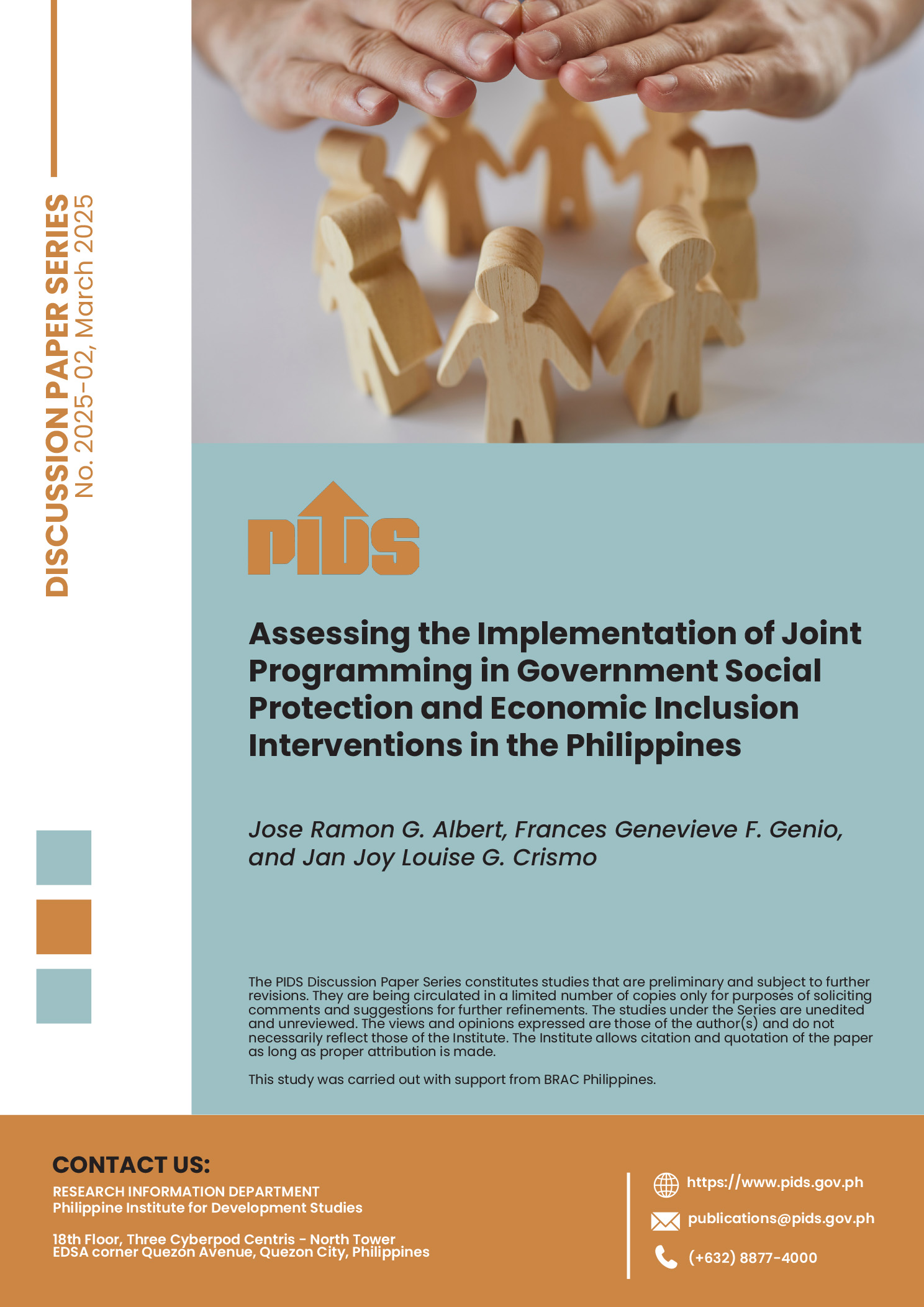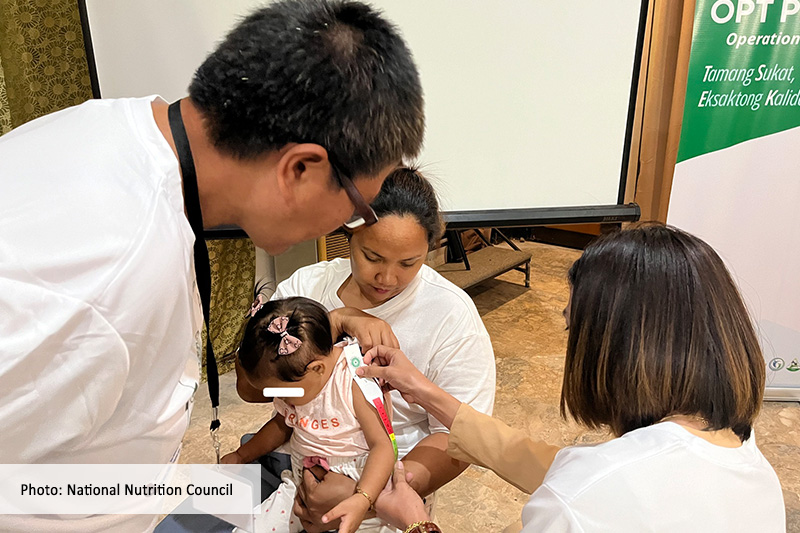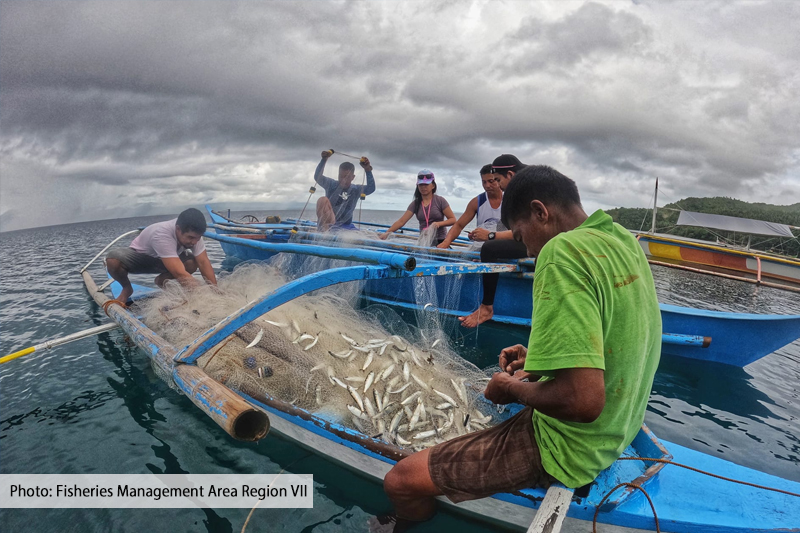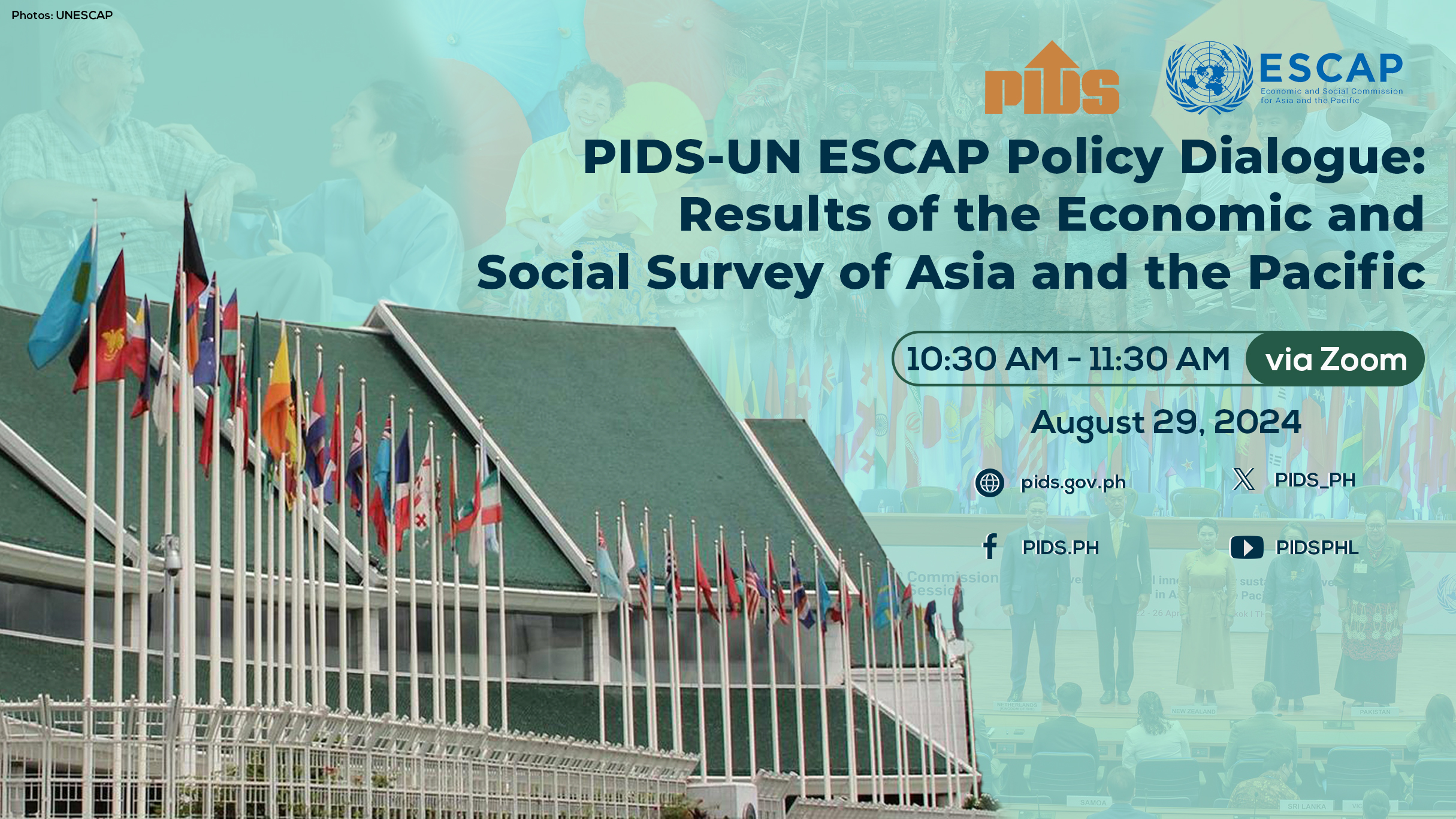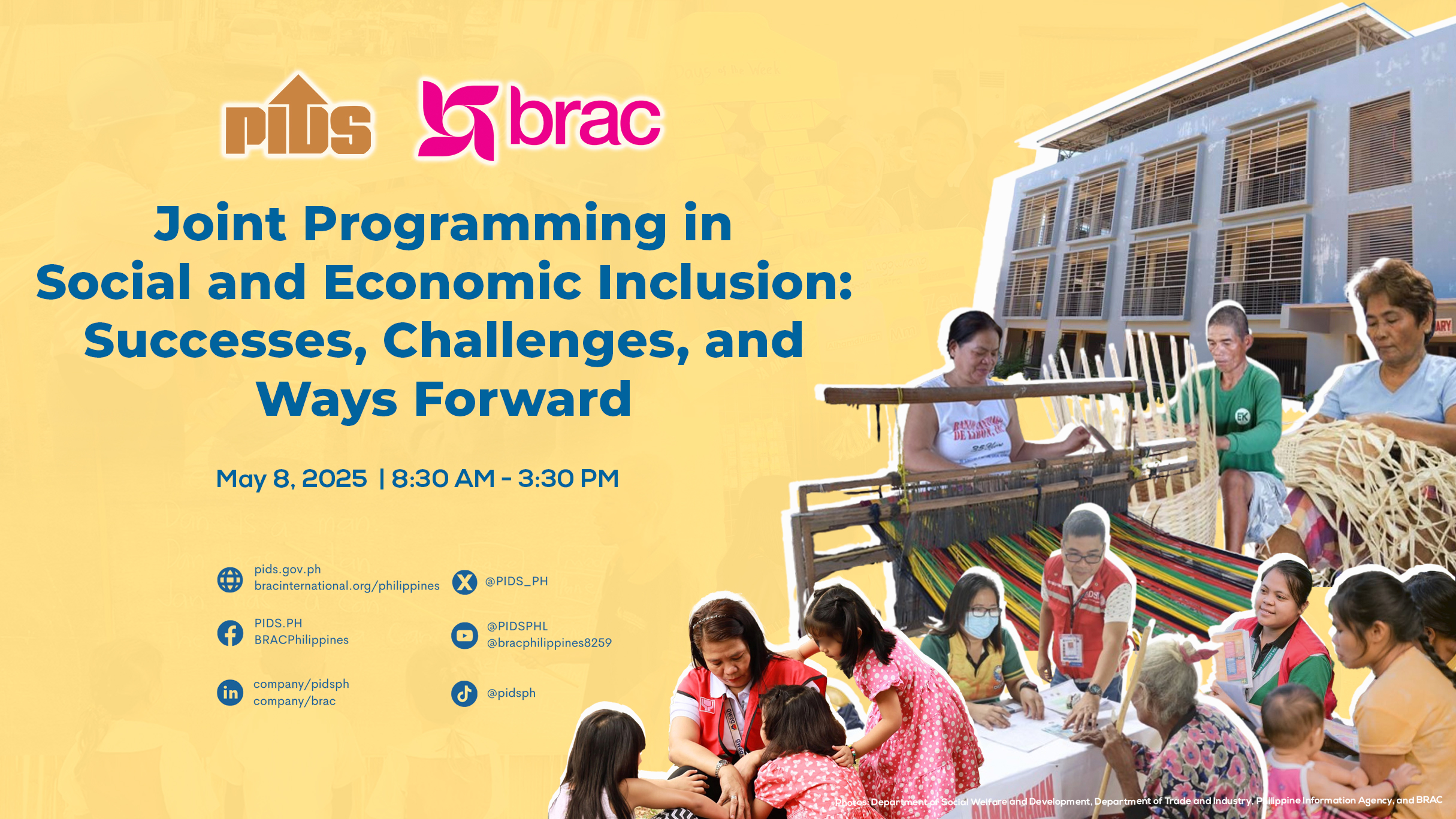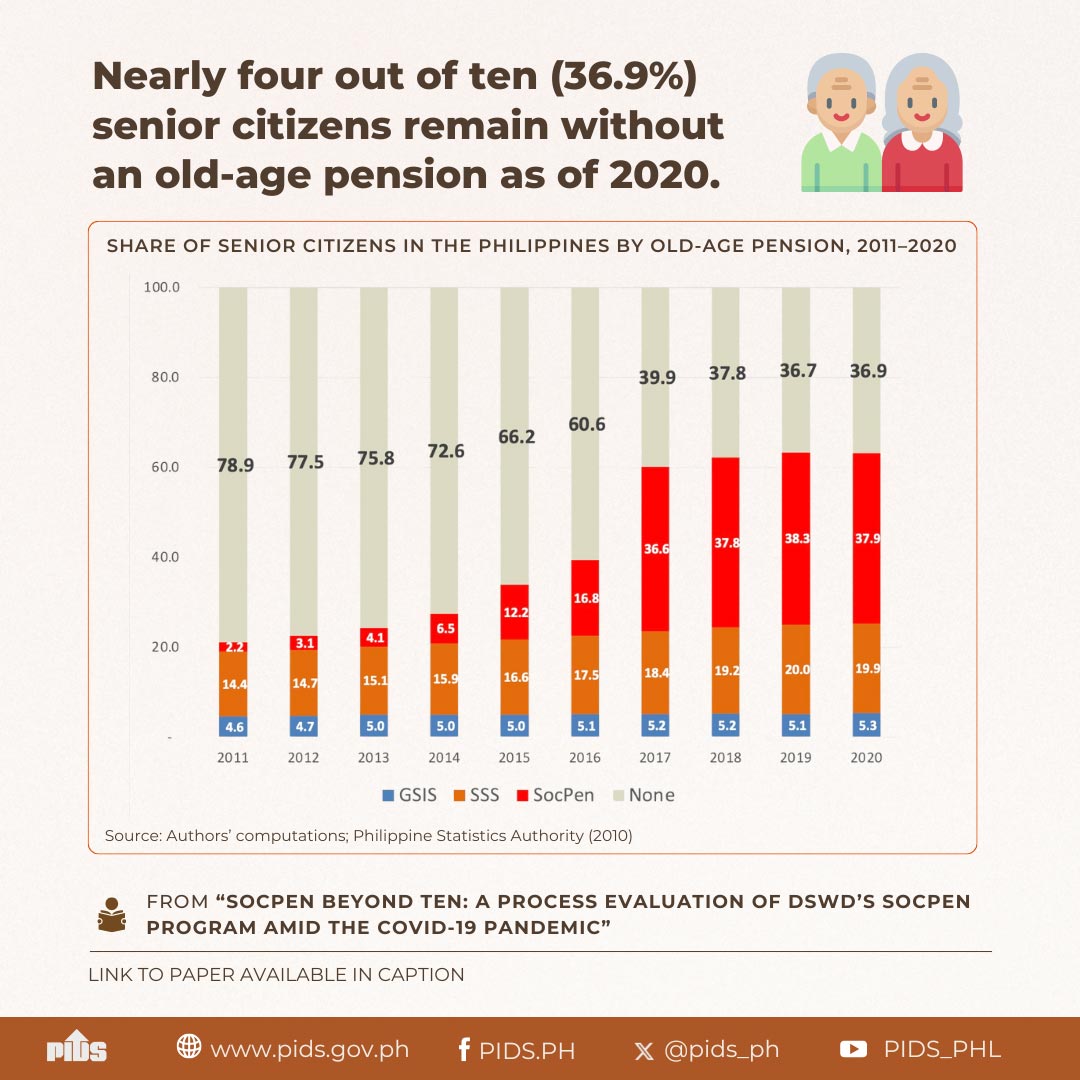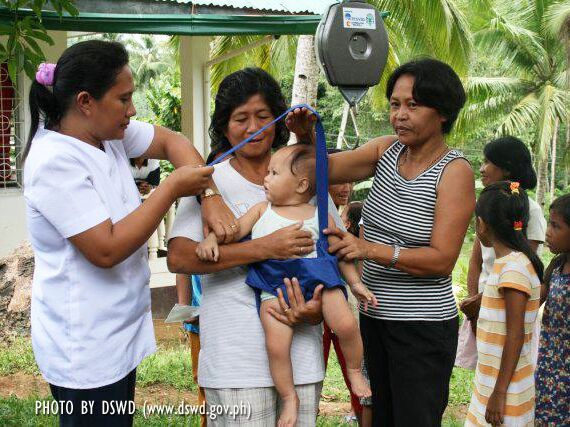
The large and rising numbers ofpoor people amid the continuing growth of the Philippine economy reflect the need for stronger and sustained efforts to protect the poor and vulnerable. Between 2009 and 2012, the proportion of the population with per capita incomes less than the poverty threshold barely declined. The magnitude of poor people also increased to 23.7 million in 2012 from 22.6 million in 2006 and 21.7 million in 1991. The poor are most vulnerable to economic downturns and crises and natural hazards whose impacts may push them further down to poverty.
Social protection thus is an important component of the government’s development policy to empower and protect the poor, vulnerable, and disadvantaged individuals from all kinds of risks. Given the large population of poor Filipinos, sustained growth that attracts investments and creates jobs are critical to achieve inclusive growth. High investments, massive infrastructure development, and employment generation need to be complemented by human capital development through programs that promote health and education improvement and facilitate equitable access to basic social services.
The Pantawid Pamilyang Pilipino Program (4Ps) is by far the largest poverty reduction and social development program implemented in the country. For its second phase, the current administration heeded the recommendations of PIDS researches to improve the program design by targeting high school completion of beneficiary children instead of merely elementary graduation. A study by Celia Reyes and Aubrey Tabuga, PIDS senior research fellow and supervising research specialist, respectively, shows that the average daily wage of a person who completed elementary is only 10 percent higher than what he would get had he been only an elementary undergraduate. However, a person who completed high school would earn 40 percent higher on the average than if he had completed only some years of elementary education. From a poverty reduction point of view, additional years of schooling can provide better employment opportunities and higher incomes for the poor.
In terms of support to specific vulnerable groups, efforts targeted to persons with disabilities (PWDs) remain wanting. There are approximately 1 million PWDs in the country or 1.23 percent of the total 88 million population in 2007. They remain among the poorest of the poor, with 30-40 percent of them being children. While there are laws present to protect and uphold the rights of PWDs, a study by Tabuga indicates that they continue to experience difficulties in exercising their privileges such as bus fare and medical care discounts. According to Tabuga, the main constraints that PWDs face are their lack of awareness of their privileges and the lack of the required identification card to avail of their privileges. In addition, many PWDs do not participate because of low self-esteem due to their immobility and unemployment. Their situation tends to be more problematic if they are residents of poorer localities. Richer local government units have the resources to implement programs for them and have the capacity to effectively assist a greater percentage of the PWD population.
The degraded state of the environment and natural resources is also mostly experienced by the poor, particularly those in the rural areas, whose livelihoods are primarily dependent on agriculture. In 2009, fishers and farmers were among the poorest groups with poverty incidences of 49.9 and 44 percent, respectively. They suffer the brunt of natural calamities. Roehlano Briones and Danilo Israel, PIDS senior research fellows, estimate that the total value of agricultural damage caused by natural calamities from 2000 to 2010 amounted to more than PHP 100 million. Agricultural insurance is an important risk protection instrument for farmers and other types of agricultural workers. While programs exist, their effectiveness remains problematic. The preliminary results of an impact assessment study of the government’s crop insurance program reveal the minimal participation of farmers. The PIDS researchers headed by Reyes report that the penetration rates of the rice and corn insurance packages of the Philippine Crop Insurance Corporation (PCIC) were below 10 percent from 1981 to 2013. Awareness of the program, including the terms and conditions of the different insurance products being offered by the PCIC, was also found to be very low.
The poor are a heterogeneous group but with a common need for empowerment and assistance to prevent and overcome adverse situations, reduce poverty, and manage economic and social risks. The current system of social protection in the Philippines is characterized by multiplicity of programs, poor coordination, high leakage due to weak targeting, inadequate information dissemination, and poor monitoring and evaluation. Auspiciously, the Philippine Development Plan 2011-2016 has emphasized “convergence of service delivery, maximized synergies, and active and strategic participation of stakeholders” as a key strategy to improve the country’s social protection program. The government is in the right direction in pursuing a convergence approach. Hopefully, this will be sustained in the next administration.
You may access PIDS studies on social protection from the SocioEconomic Research Portal for the Philippines. Simply type ‘social protection’, ‘poverty’, persons with disabilities’, and other relevant keywords in the Search box.
Social Protection in the Philippines: Current State and Challenges
Public-Private Partnership Options toward Achieving Universal Health Coverage in the Philippine Setting
The Sponsored Program of the Philippine National Health Insurance - Analyses of the Actual Coverage and Variations Across Regions and Provinces
Reconnaissance Study on the Implementation of Case-Based Payments
Feasibility of Supplemental Funds from the Private Sector for Catastrophic Illness Financing
Analysis of Catastrophic Health Financing by Key Institutions
Fiscal Costs of Subsidies for Socialized Housing Programs: an Update
Impacts of Natural Disasters on Agriculture, Food Security, and Natural Resources and Environment in the Philippines
What Constrains PWDs to Participate in Discount Privileges? The Case of Bus Fare and Medical Care Discounts in the Philippines
Promoting Inclusive Growth through the 4Ps
Policy Awareness and Participation by Persons with Disability in the Philippines
Review of Design and Implementation of the Agricultural
Insurance Programs of the Philippine Crop Insurance Corporation
Social protection thus is an important component of the government’s development policy to empower and protect the poor, vulnerable, and disadvantaged individuals from all kinds of risks. Given the large population of poor Filipinos, sustained growth that attracts investments and creates jobs are critical to achieve inclusive growth. High investments, massive infrastructure development, and employment generation need to be complemented by human capital development through programs that promote health and education improvement and facilitate equitable access to basic social services.
The Pantawid Pamilyang Pilipino Program (4Ps) is by far the largest poverty reduction and social development program implemented in the country. For its second phase, the current administration heeded the recommendations of PIDS researches to improve the program design by targeting high school completion of beneficiary children instead of merely elementary graduation. A study by Celia Reyes and Aubrey Tabuga, PIDS senior research fellow and supervising research specialist, respectively, shows that the average daily wage of a person who completed elementary is only 10 percent higher than what he would get had he been only an elementary undergraduate. However, a person who completed high school would earn 40 percent higher on the average than if he had completed only some years of elementary education. From a poverty reduction point of view, additional years of schooling can provide better employment opportunities and higher incomes for the poor.
In terms of support to specific vulnerable groups, efforts targeted to persons with disabilities (PWDs) remain wanting. There are approximately 1 million PWDs in the country or 1.23 percent of the total 88 million population in 2007. They remain among the poorest of the poor, with 30-40 percent of them being children. While there are laws present to protect and uphold the rights of PWDs, a study by Tabuga indicates that they continue to experience difficulties in exercising their privileges such as bus fare and medical care discounts. According to Tabuga, the main constraints that PWDs face are their lack of awareness of their privileges and the lack of the required identification card to avail of their privileges. In addition, many PWDs do not participate because of low self-esteem due to their immobility and unemployment. Their situation tends to be more problematic if they are residents of poorer localities. Richer local government units have the resources to implement programs for them and have the capacity to effectively assist a greater percentage of the PWD population.
The degraded state of the environment and natural resources is also mostly experienced by the poor, particularly those in the rural areas, whose livelihoods are primarily dependent on agriculture. In 2009, fishers and farmers were among the poorest groups with poverty incidences of 49.9 and 44 percent, respectively. They suffer the brunt of natural calamities. Roehlano Briones and Danilo Israel, PIDS senior research fellows, estimate that the total value of agricultural damage caused by natural calamities from 2000 to 2010 amounted to more than PHP 100 million. Agricultural insurance is an important risk protection instrument for farmers and other types of agricultural workers. While programs exist, their effectiveness remains problematic. The preliminary results of an impact assessment study of the government’s crop insurance program reveal the minimal participation of farmers. The PIDS researchers headed by Reyes report that the penetration rates of the rice and corn insurance packages of the Philippine Crop Insurance Corporation (PCIC) were below 10 percent from 1981 to 2013. Awareness of the program, including the terms and conditions of the different insurance products being offered by the PCIC, was also found to be very low.
The poor are a heterogeneous group but with a common need for empowerment and assistance to prevent and overcome adverse situations, reduce poverty, and manage economic and social risks. The current system of social protection in the Philippines is characterized by multiplicity of programs, poor coordination, high leakage due to weak targeting, inadequate information dissemination, and poor monitoring and evaluation. Auspiciously, the Philippine Development Plan 2011-2016 has emphasized “convergence of service delivery, maximized synergies, and active and strategic participation of stakeholders” as a key strategy to improve the country’s social protection program. The government is in the right direction in pursuing a convergence approach. Hopefully, this will be sustained in the next administration.
You may access PIDS studies on social protection from the SocioEconomic Research Portal for the Philippines. Simply type ‘social protection’, ‘poverty’, persons with disabilities’, and other relevant keywords in the Search box.
Social Protection in the Philippines: Current State and Challenges
Public-Private Partnership Options toward Achieving Universal Health Coverage in the Philippine Setting
The Sponsored Program of the Philippine National Health Insurance - Analyses of the Actual Coverage and Variations Across Regions and Provinces
Reconnaissance Study on the Implementation of Case-Based Payments
Feasibility of Supplemental Funds from the Private Sector for Catastrophic Illness Financing
Analysis of Catastrophic Health Financing by Key Institutions
Fiscal Costs of Subsidies for Socialized Housing Programs: an Update
Impacts of Natural Disasters on Agriculture, Food Security, and Natural Resources and Environment in the Philippines
What Constrains PWDs to Participate in Discount Privileges? The Case of Bus Fare and Medical Care Discounts in the Philippines
Promoting Inclusive Growth through the 4Ps
Policy Awareness and Participation by Persons with Disability in the Philippines
Review of Design and Implementation of the Agricultural
Insurance Programs of the Philippine Crop Insurance Corporation

